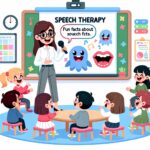Are you tired of struggling with speech disorders that hinder your everyday communication? Look no further. In this article, we will delve into the world of speech therapy techniques that can significantly boost your confidence and improve your communication skills. Whether you’re a parent seeking assistance for your child or an individual looking to overcome your own speech challenges, we’ve got you covered. Prepare to discover a range of effective strategies and evidence-based techniques that will empower you to overcome obstacles and achieve your communication goals. Let’s embark on this transformative journey together, as we explore the power of speech therapy.

Speech Therapy Techniques
Speech therapy techniques are highly effective tools used by speech-language pathologists (SLPs) and speech therapists to improve speech clarity, fluency, and overall communication skills. These techniques are tailored to address specific communication disorders such as articulation difficulties, language comprehension issues, fluency disorders, and cognitive impairments. By incorporating a variety of strategies and exercises, speech therapy techniques help individuals overcome their communication challenges and boost their confidence in expressing themselves.
The Power of Tongue and Mouth Exercises
One of the fundamental speech therapy techniques focuses on improving tongue and mouth coordination. These exercises target the muscles responsible for speech production, enabling individuals to articulate words and sounds more accurately. With the guidance of a skilled SLP, patients may practice movements such as tongue twisters, stretching exercises, and tongue strengthening exercises. By engaging in these activities, individuals can strengthen their speech muscles and enhance their ability to pronounce words clearly and effectively.
“Tongue and mouth exercises are like weightlifting for your speech muscles. They help you build strength and control, allowing you to speak with confidence and clarity.”
Unlocking Facial Movements for Expressive Speech
Facial movements play a vital role in conveying emotions and expressing oneself. SLPs often incorporate facial exercises as part of speech therapy techniques, helping individuals develop greater control and awareness of their facial muscles. These exercises may involve mimicking facial expressions, exaggerating mouth movements, and performing facial massages. As individuals become more adept at manipulating their facial muscles, their ability to communicate emotions and thoughts more effectively improves significantly.
“Your face is a powerful instrument of expression. By practicing facial movements, you unlock the potential to communicate with impact and authenticity.”
Enhancing Communication Through Reading Out Loud
Reading out loud is an excellent exercise that enhances speech fluency and comprehension skills. This speech therapy technique encourages individuals to practice articulating words, phrases, and sentences in a controlled and structured manner. By reading aloud, individuals develop better breath control, rhythm, and intonation, crucial elements for clear and engaging speech. Additionally, this technique improves reading comprehension, allowing individuals to understand and interpret written information more effectively.
“Reading out loud is more than just an activity; it’s a pathway to confident and expressive communication. Each word you articulate brings you one step closer to unlocking your full potential.”
Social Communication Activities: Your Key to Interpersonal Skills
Speech therapy techniques extend beyond the mechanics of speech production. Social communication activities help individuals develop essential interpersonal skills and navigate social interactions with confidence. These activities may involve practicing conversational turn-taking, interpreting nonverbal cues, and engaging in role-playing scenarios. By participating in these activities, individuals gain a deeper understanding of social norms and acquire the tools necessary for successful communication in various social settings.
“Communication is a dance, and social communication activities provide you with the graceful steps needed to navigate any social setting. Together, we’ll unlock your ability to connect with others, leaving a lasting impression.”
The Power of Breath: Breathing Exercises in Speech Therapy
Breath control is a crucial aspect of effective speech. Incorporating breathing exercises is a common speech therapy technique aimed at improving voice projection, articulation, and overall speech clarity. These exercises teach individuals how to regulate their breath, ensuring a steady and controlled flow of air during speech production. By mastering breath control techniques, individuals can speak with confidence, maintaining a clear and consistent tone throughout their communication.
“Your breath is the foundation of your voice, and through targeted breathing exercises, we’ll build a strong and steady voice that commands attention and inspires confidence.”
The Multifaceted Approach: Sign Language and Speech Therapy
In certain cases, speech therapy techniques may involve the use of alternative communication methods, such as sign language. Sign language is a visual language that utilizes hand gestures, facial expressions, and body movements to convey meaning. Combining sign language with speech therapy techniques can be highly effective for individuals with severe communication disorders or those who struggle with verbal expression. Learning sign language not only expands their communication options but also empowers them to express their thoughts and needs more effectively.
“When verbal communication faces challenges, sign language steps in as a powerful ally. It opens doors to meaningful connections, allowing you to communicate confidently and authentically.”
In conclusion, speech therapy techniques offer individuals the opportunity to overcome their communication difficulties, boost their confidence, and achieve their communication goals. Whether through tongue and mouth exercises, facial movements, reading out loud, social communication activities, breathing exercises, or the use of sign language, these techniques provide a holistic approach to enhance speech clarity and overall communication skills. With the support of a skilled speech-language pathologist, individuals can unlock their full potential and embrace a future where effective communication becomes second nature.
“Speech therapy techniques are the keys that unlock the door to confident communication. Embrace these techniques, and watch as your voice soars and your confidence soars alongside it.”
Speech is a fascinating and powerful form of communication. Whether it’s a political speech that moves nations or a heartfelt toast at a wedding, the spoken word has the ability to captivate and inspire. If you’re someone who is curious to learn more about the art of speech, we’ve got you covered. Dive into our collection of Interesting Facts About Speech and discover the secrets behind persuasive rhetoric, extraordinary orators, and the impact of language on our society. Prepare to be amazed as you uncover the hidden gems of the spoken word. So what are you waiting for? Click here to explore these intriguing facts and expand your knowledge on the fascinating world of speech.
FAQ
Question 1
What are some common speech therapy techniques used to improve communication skills?
Answer 1
Some common speech therapy techniques used to improve communication skills include tongue and mouth exercises, facial movements, reading out loud, social communication activities, breathing exercises, and the use of sign language.
Question 2
What is the role of a speech-language pathologist in speech therapy?
Answer 2
A speech-language pathologist, also known as a speech therapist, is responsible for assessing and diagnosing communication disorders, developing individualized treatment plans, and implementing various speech therapy techniques to help individuals improve their speech and language skills.
Question 3
Can speech therapy techniques benefit children with speech disorders?
Answer 3
Yes, speech therapy techniques can be highly beneficial for children with speech disorders such as late talkers, apraxia, stuttering, and aphasia. These techniques help improve speech clarity and confidence, promoting better communication skills.
Question 4
How can parents support their child’s speech development at home?
Answer 4
Parents can support their child’s speech development at home by utilizing speech therapy techniques such as using silly words and sentences, following the child’s lead, and providing positive reinforcement. Engaging in informal interactions and focused speech-language exercises tailored to the child’s needs can also be helpful.
Question 5
In what settings can speech therapy be conducted?
Answer 5
Speech therapy can be conducted in various settings including classrooms, small groups, or on a one-on-one basis. The setting may depend on the individual’s specific needs and goals. Various techniques and strategies are used to enhance communication skills and achieve successful outcomes.
- Unlock Water’s Symbolism: A Cross-Cultural Exploration - April 20, 2025
- Identify Black and White Snakes: Venomous or Harmless? - April 20, 2025
- Unlocking Potential: Origins High School’s NYC Story - April 20, 2025















